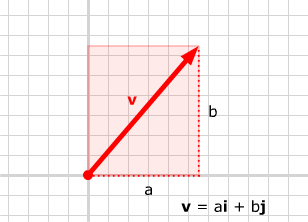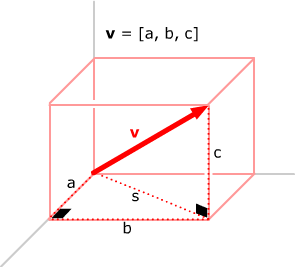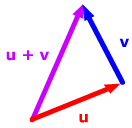
Calculating
the length of a vector in 2-space in terms of its components is a direct
application of the theorem of Pythagoras. Suppose
v =
ai + bj .

The length of a vector is also called the norm of the vector.

Calculating
the length of a vector in 3-space in terms of its components is a double application
of the theorem of Pythagoras. Suppose
v = ai +
bj + ck.

Rules for calculating with vector lengths
For any geometric vectors u and v and any scalar c,
- ||0|| = 0
- If u ≠ 0, then ||u|| > 0.
- ||cu|| = |c| ||u||
- ||u + v|| ≤ ||u||+||v|| (triangle inequality)

The first three rules are clear from the geometry of vectors and their components. The triangle inequality just says that the length of any side of a triangle is no greater than than the sum of the lengths of the other two sides - apply that observation to the triangle rule for addition of vectors.
Suppose we have a non-zero vector v in the
appropriate direction. We need a unit vector in the same direction, i.e.
we need to multiply v by a scalar so that the
result has length 1. Since v has length ||v||,
if we multiply v by the reciprocal of ||v||, the
resulting vector will have length 1: the normalized vector is ![]() .
.
Thus:
To normalize any non-zero vector in 2-space or 3-space, multiply that vector by the reciprocal of its length.
 Vectors
in Coordinate Systems Vectors
in Coordinate Systems |
||||
| Introduction | Two-dimensional coordinate systems | Three-dimensional coordinate systems | Using components to calculate with vectors | Calculating the length of a vector |